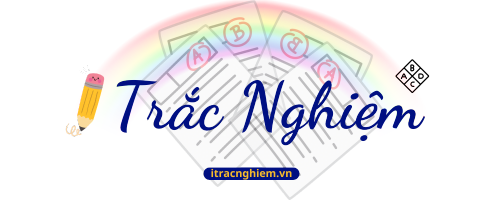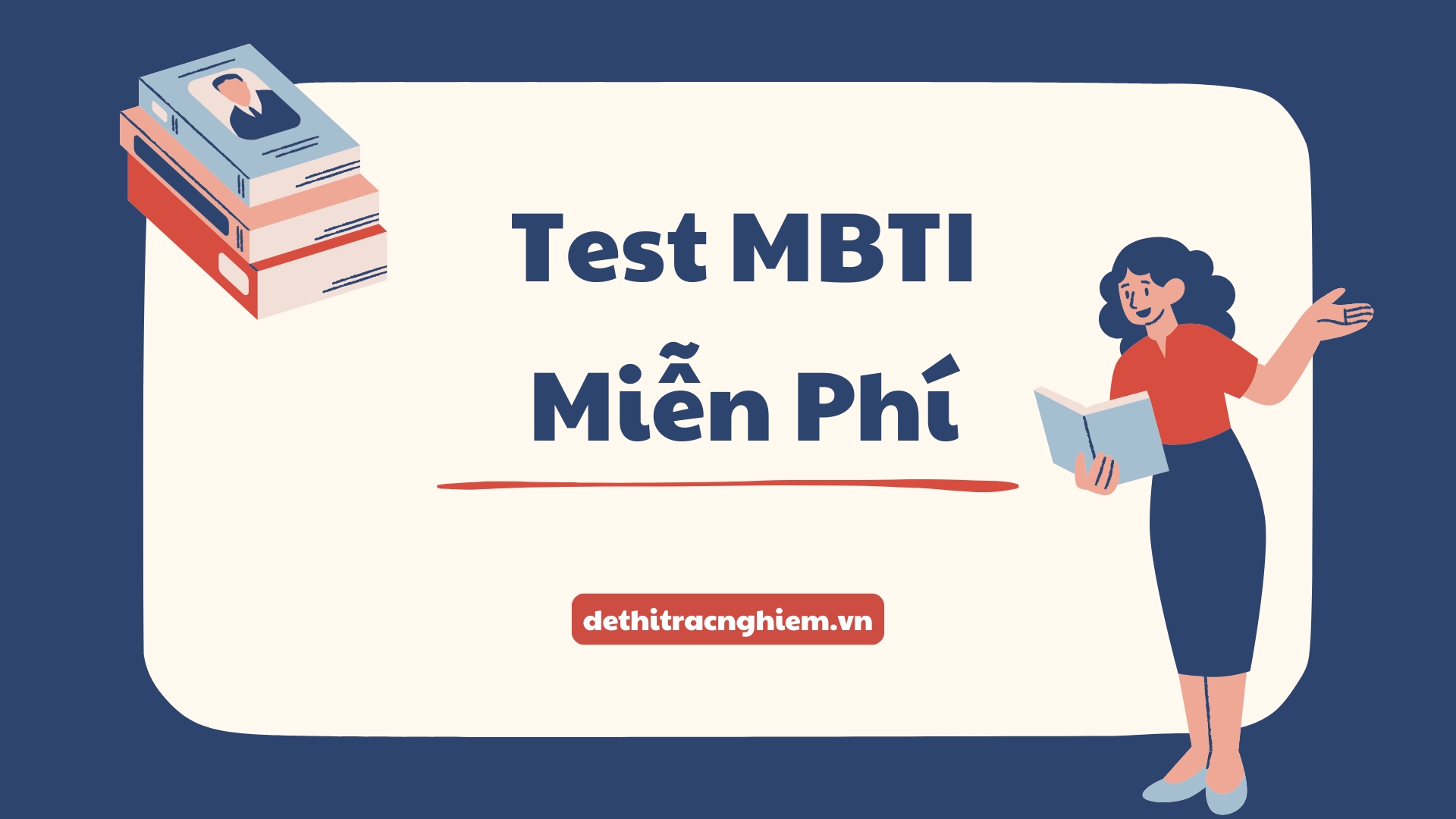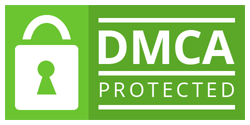Đề thi thử Đại học 2025 môn Tiếng Anh – THPT Đào Duy Từ – Thanh Hóa (Lần 2) là một trong những đề tiêu biểu thuộc Tổng hợp đề thi thử môn Tiếng Anh THPT QG, nằm trong chương trình Đề thi vào Đại học. Đây là đề thi thử lần thứ hai của Trường THPT Đào Duy Từ – Thanh Hóa, được xây dựng công phu với mục tiêu giúp học sinh lớp 12 tăng tốc ôn luyện, nâng cao kỹ năng làm bài trắc nghiệm tiếng Anh trước kỳ thi Tốt nghiệp THPT Quốc gia năm 2025.
Đề thi bao gồm đầy đủ các phần quen thuộc: ngữ âm (phát âm – trọng âm), ngữ pháp – từ vựng, đọc hiểu, viết lại câu, giao tiếp ngôn ngữ, và tìm lỗi sai, bám sát cấu trúc đề minh họa mới nhất từ Bộ GD&ĐT. Điểm nổi bật của đề là có sự phân hóa rõ rệt, giúp học sinh vừa ôn tập kiến thức cơ bản, vừa rèn luyện các câu hỏi vận dụng – vận dụng cao phục vụ mục tiêu xét tuyển đại học.
Hãy cùng Dethitracnghiem.vn khám phá đề thi thử lần 2 của trường THPT Đào Duy Từ và làm bài ngay để đánh giá chính xác năng lực hiện tại của bạn!
- Số trang: 4 trang
- Hình thức: Trắc nghiệm
- Thời gian làm bài: 50 phút (không kể thời gian phát đề)
ĐỀ THI THỬ ĐẠI HỌC MÔN TIẾNG ANH NĂM 2025 THPT ĐÀO DUY TỪ – THANH HÓA
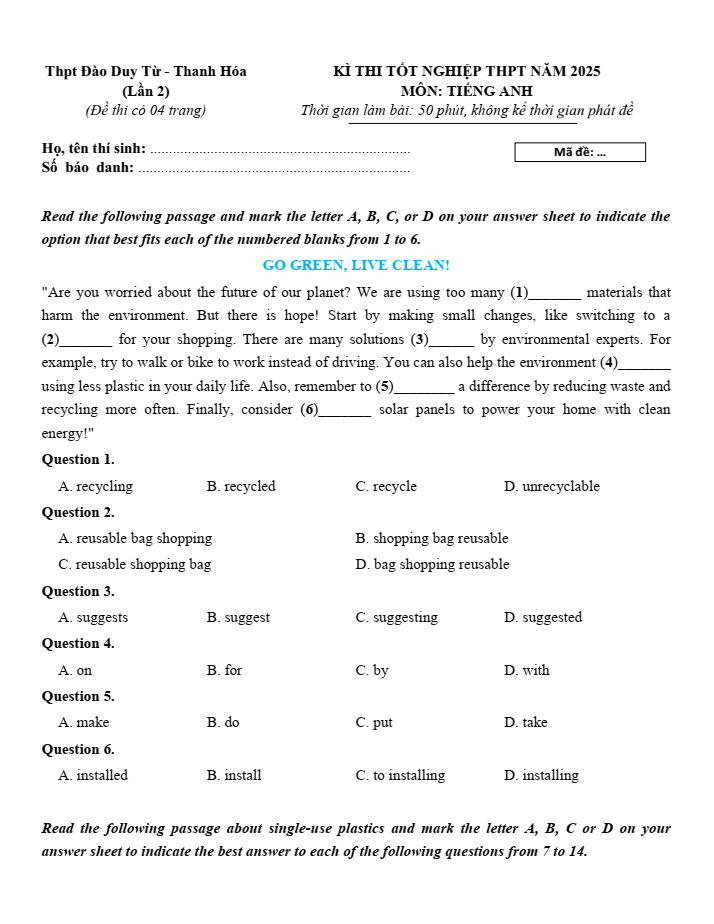
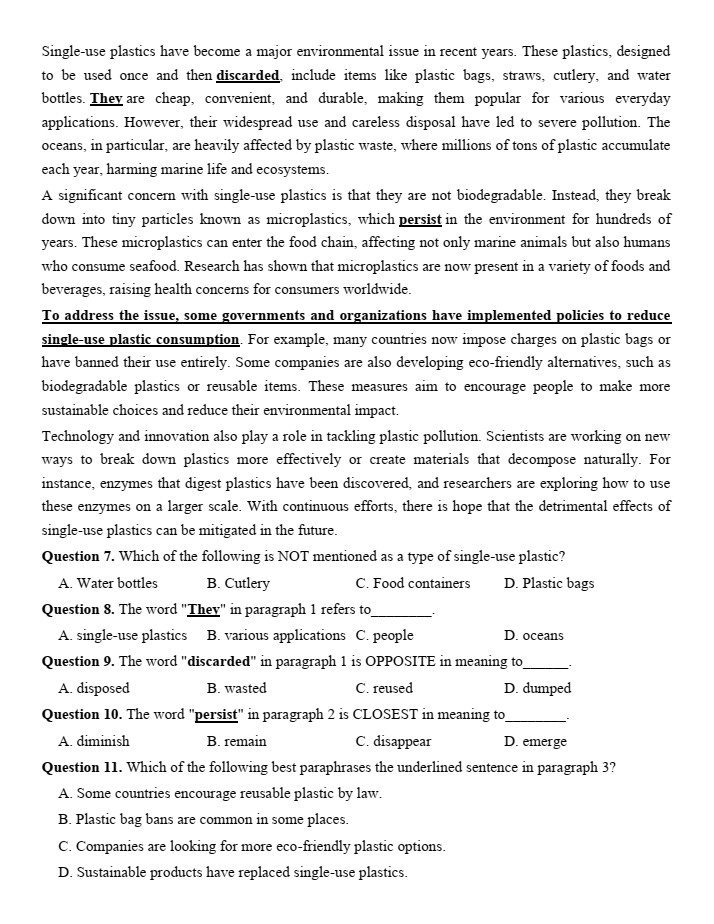
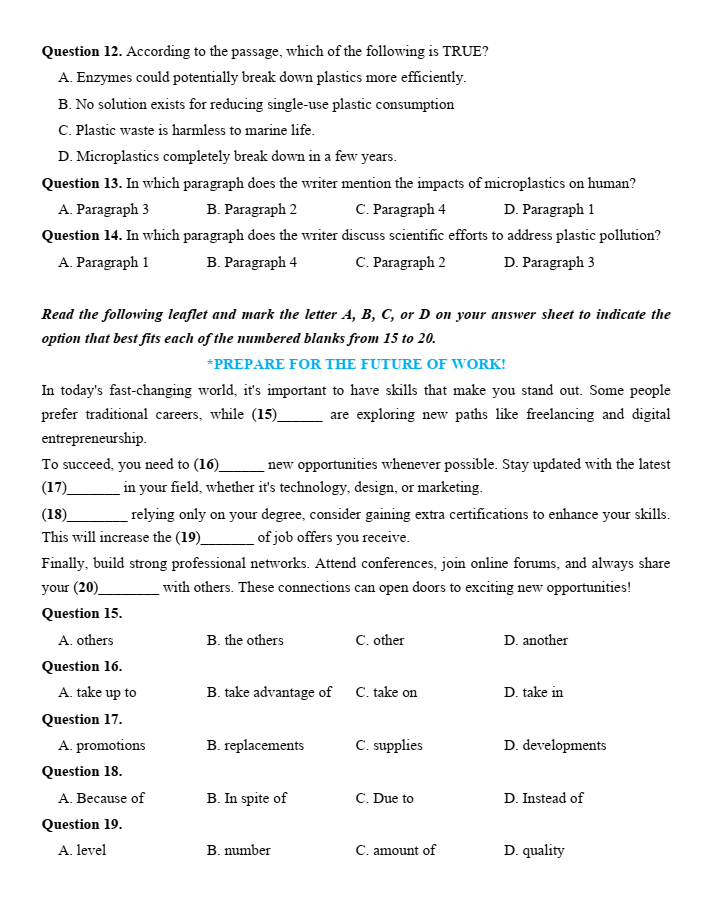
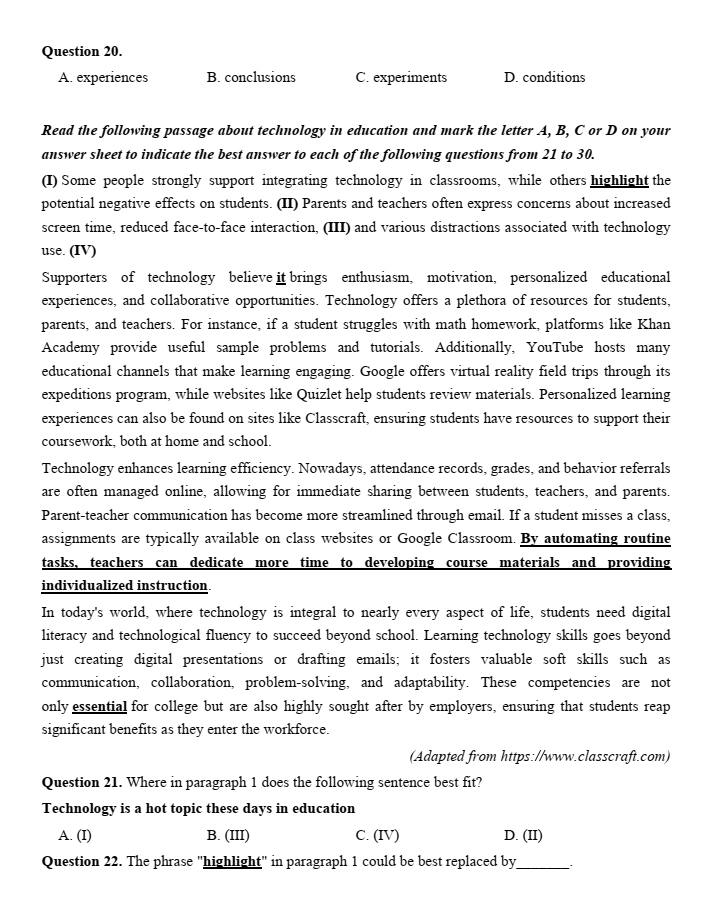
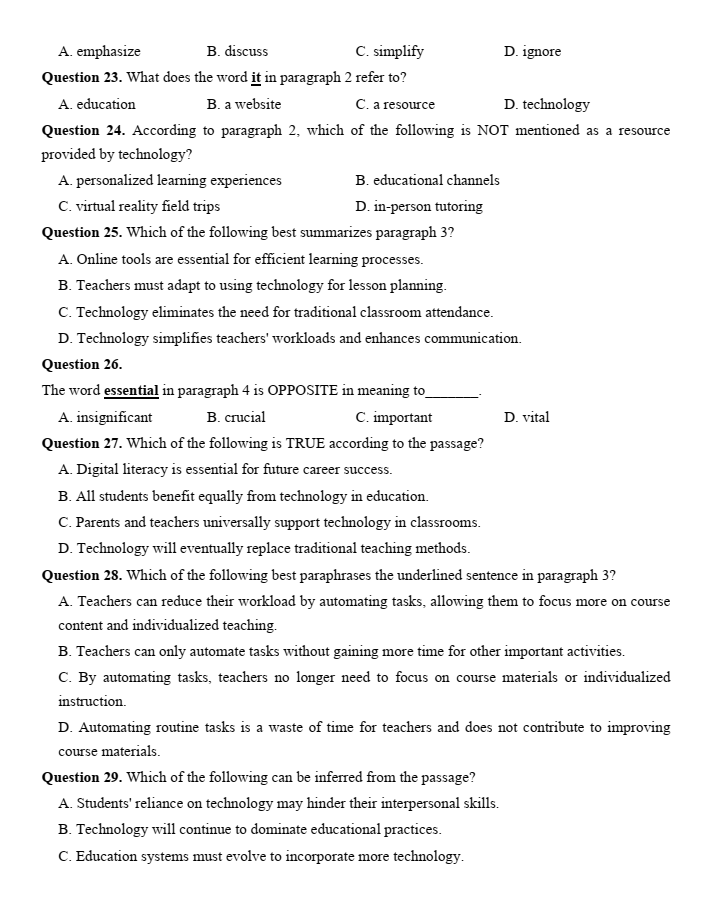
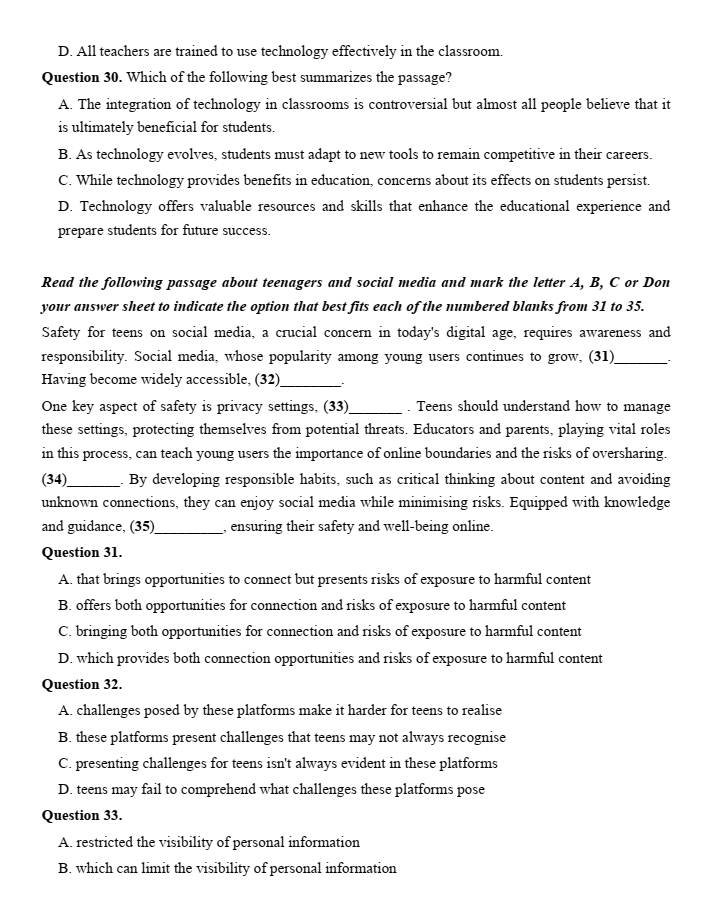
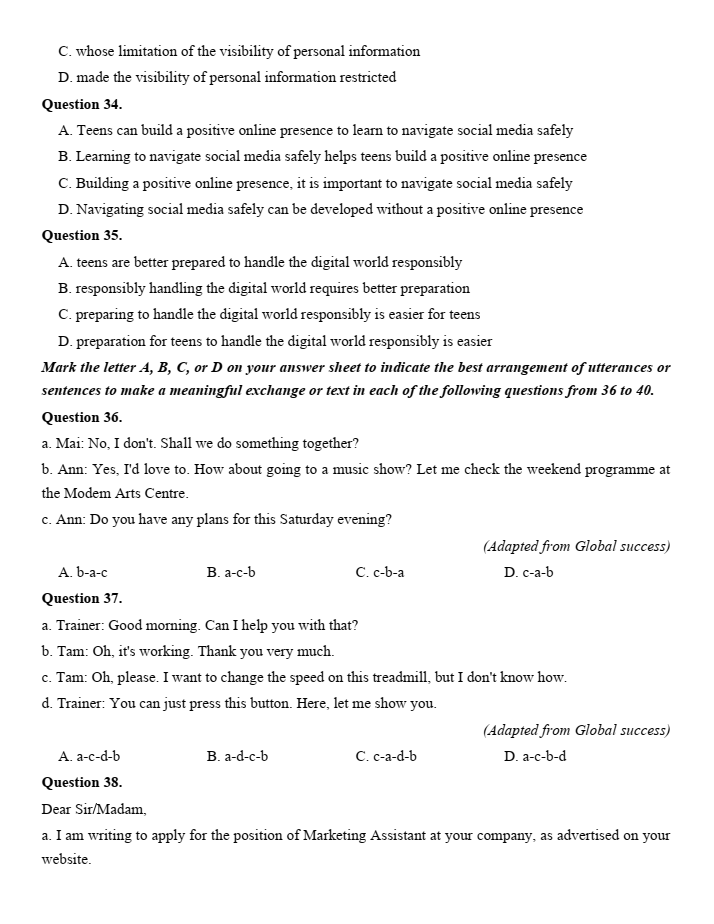
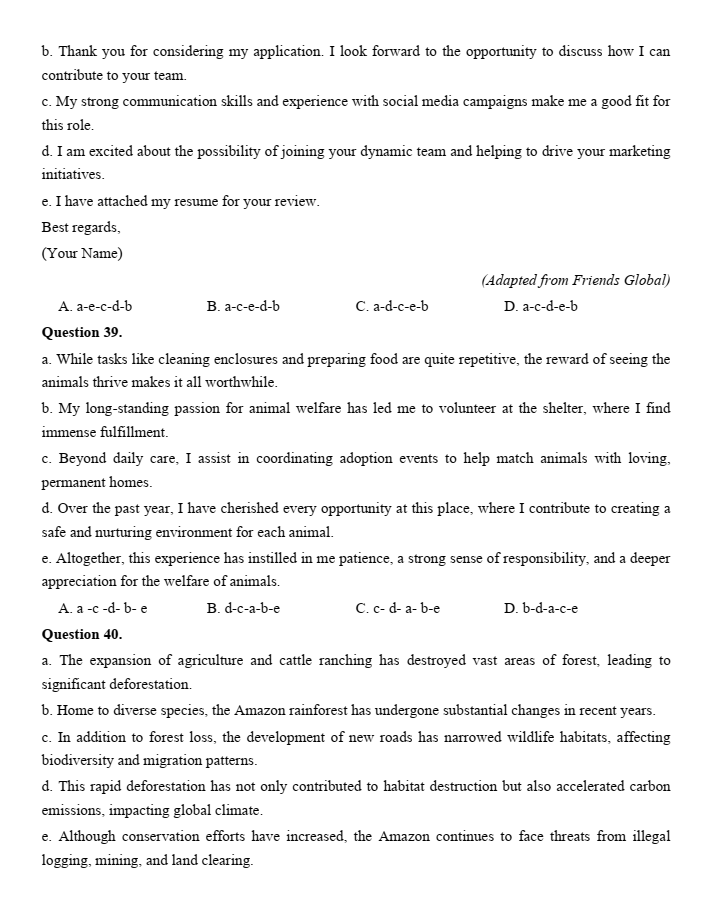

Read the following passage and mark the letter A, B, C, or D on your answer sheet to indicate the option that best fits each of the numbered blanks from 1 to 6.
GO GREEN, LIVE CLEAN!
“Are you worried about the future of our planet? We are using too many (1)_____ materials that harm the environment. But there is hope! Start by making small changes, like switching to a (2)_____ for your shopping. There are many solutions (3)_____ by environmental experts. For example, try to walk or bike to work instead of driving. You can also help the environment (4)_____ using less plastic in your daily life. Also, remember to (5)_____ a difference by reducing waste and recycling more often. Finally, consider (6)_____ solar panels to power your home with clean energy!”
Question 1.
A. recycling
B. recycled
C. recycle
D. unrecyclable
Question 2.
A. reusable bag shopping
B. shopping bag reusable
C. reusable shopping bag
D. bag shopping reusable
Question 3.
A. suggests
B. suggest
C. suggesting
D. suggested
Question 4.
A. on
B. for
C. by
D. with
Question 5.
A. make
B. do
C. put
D. take
Question 6.
A. installed
B. install
C. to installing
D. installing
Read the following passage about single-use plastics and mark the letter A, B, C or D on your answer sheet to indicate the best answer to each of the following questions from 7 to 14.
Single-use plastics have become a major environmental issue in recent years. These plastics, designed to be used once and then discarded, include items like plastic bags, straws, cutlery, and water bottles. They are cheap, convenient, and durable, making them popular for various everyday applications. However, their widespread use and careless disposal have led to severe pollution. The oceans, in particular, are heavily affected by plastic waste, where millions of tons of plastic accumulate each year, harming marine life and ecosystems.
A significant concern with single-use plastics is that they are not biodegradable. Instead, they break down into tiny particles known as microplastics, which persist in the environment for hundreds of years. These microplastics can enter the food chain, affecting not only marine animals but also humans who consume seafood. Research has shown that microplastics are now present in a variety of foods and beverages, raising health concerns for consumers worldwide.
To address the issue, some governments and organizations have implemented policies to reduce single-use plastic consumption. For example, many countries now impose charges on plastic bags or have banned their use entirely. Some companies are also developing eco-friendly alternatives, such as biodegradable plastics or reusable items. These measures aim to encourage people to make more sustainable choices and reduce their environmental impact.
Technology and innovation also play a role in tackling plastic pollution. Scientists are working on new ways to break down plastics more effectively or create materials that decompose naturally. For instance, enzymes that digest plastics have been discovered, and researchers are exploring how to use these enzymes on a larger scale. With continuous efforts, there is hope that the detrimental effects of single-use plastics can be mitigated in the future.
Question 7. Which of the following is NOT mentioned as a type of single-use plastic?
A. Water bottles
B. Cutlery
C. Food containers
D. Plastic bags
Question 8. The word “They” in paragraph 1 refers to _____.
A. single-use plastics
B. various applications
C. people
D. oceans
Question 9. The word “discarded” in paragraph 1 is OPPOSITE in meaning to _____.
A. disposed
B. wasted
C. reused
D. dumped
Question 10. The word “persist” in paragraph 2 is CLOSEST in meaning to _____.
A. diminish
B. remain
C. disappear
D. emerge
Question 11. Which of the following best paraphrases the underlined sentence in paragraph 3?
A. Some countries encourage reusable plastic by law.
B. Plastic bag bans are common in some places.
C. Companies are looking for more eco-friendly plastic options.
D. Sustainable products have replaced single-use plastics.
Question 12. According to the passage, which of the following is TRUE?
A. Enzymes could potentially break down plastics more efficiently.
B. No solution exists for reducing single-use plastic consumption
C. Plastic waste is harmless to marine life.
D. Microplastics completely break down in a few years.
Question 13. In which paragraph does the writer mention the impacts of microplastics on human?
A. Paragraph 3
B. Paragraph 2
C. Paragraph 4
D. Paragraph 1
Question 14. In which paragraph does the writer discuss scientific efforts to address plastic pollution?
A. Paragraph 1
B. Paragraph 4
C. Paragraph 2
D. Paragraph 3
Read the following leaflet and mark the letter A, B, C or D on your answer sheet to indicate the option that best fits each of the numbered blanks from 15 to 20.
PREPARE FOR THE FUTURE OF WORK!
In today’s fast-changing world, it’s important to have skills that make you stand out. Some people prefer traditional careers, while (15)_____ are exploring new paths like freelancing and digital entrepreneurship. To succeed, you need to (16)_____ new opportunities whenever possible. Stay updated with the latest (17)_____ in your field, whether it’s technology, design, or marketing. (18)_____ relying on your degree, consider gaining extra certifications to enhance your skills. This will increase the (19)_____ of job offers you receive. Finally, build strong professional networks. Attend conferences, join online forums, and always share your (20)_____ with others. These connections can open doors to exciting new opportunities!
Question 15.
A. others
B. the others
C. other
D. another
Question 16.
A. take up to
B. take advantage of
C. take on
D. take in
Question 17.
A. promotions
B. replacements
C. supplies
D. developments
Question 18.
A. Because of
B. In spite of
C. Due to
D. Instead of
Question 19.
A. level
B. number
C. amount of
D. quality
Question 20.
A. experiences
B. conclusions
C. experiments
D. conditions
Read the following passage about technology in education and mark the letter A, B, C or D on your answer sheet to indicate the best answer to each of the following questions from 21 to 30.
(I) Some people strongly support integrating technology in classrooms, while others highlight the potential negative effects on students. (II) Parents and teachers often express concerns about increased screen time, reduced face-to-face interaction, (III) and various distractions associated with technology use. (IV)
Supporters of technology believe it brings enthusiasm, motivation, personalized educational experiences, and collaborative opportunities. Technology offers a plethora of resources for students, parents, and teachers. For instance, if a student struggles with math homework, platforms like Khan Academy provide useful sample problems and tutorials. Additionally, YouTube hosts many educational channels that make learning engaging. Google offers virtual reality field trips through its expeditions program, while websites like Quizlet help students review materials. Personalized learning experiences can also be found on sites like Classcraft, ensuring students have resources to support their coursework, both at home and school.
Technology enhances learning efficiency. Nowadays, attendance records, grades, and behavior referrals are often managed online, allowing for immediate sharing between students, teachers, and parents. Parent-teacher communication has become more streamlined through email. If a student misses a class, assignments are typically available on class websites or Google Classroom. By automating routine tasks, teachers can dedicate more time to developing course materials and providing individualized instruction.
In today’s world, where technology is integral to nearly every aspect of life, students need digital literacy and technological fluency to succeed beyond school. Learning technology skills goes beyond just creating digital presentations or drafting emails; it fosters valuable soft skills such as communication, collaboration, problem-solving, and adaptability. These competencies are not only essential for college but are also highly sought after by employers, ensuring that students reap significant benefits as they enter the workforce.
(Adapted from https://www.classcraft.com)
Question 21. Where in paragraph 1 does the following sentence best fit? “Technology is a hot topic these days in education.”
A. (I)
B. (III)
C. (IV)
D. (II)
Question 22. The phrase “highlight” in paragraph 1 could be best replaced by _____.
A. emphasize
B. discuss
C. simplify
D. ignore
Question 23. What does the word “it” in paragraph 2 refer to?
A. education
B. a website
C. a resource
D. technology
Question 24. According to paragraph 2, which of the following is NOT mentioned as a resource provided by technology?
A. personalized learning experiences
B. educational channels
C. virtual reality field trips
D. in-person tutoring
Question 25. Which of the following best summarizes paragraph 3?
A. Online tools are essential for efficient learning processes.
B. Teachers must adapt to using technology for lesson planning.
C. Technology eliminates the need for traditional classroom attendance.
D. Technology simplifies teachers’ workloads and enhances communication.
Question 26. The word “essential” in paragraph 4 is OPPOSITE in meaning to _____.
A. insignificant
B. crucial
C. important
D. vital
Question 27. Which of the following is TRUE according to the passage?
A. Digital literacy is essential for future career success.
B. All students benefit equally from technology in education.
C. Parents and teachers universally support technology in classrooms.
D. Technology will eventually replace traditional teaching methods.
Question 28. Which of the following best paraphrases the underlined sentence in paragraph 3? “By automating routine tasks, teachers can dedicate more time to developing course materials and providing individualized instruction.”
A. Teachers can reduce their workload by automating tasks, allowing them to focus more on course content and individualized teaching.
B. Teachers can only automate tasks without gaining more time for other important activities.
C. By automating tasks, teachers no longer need to focus on course materials or individualized instruction.
D. Automating routine tasks is a waste of time for teachers and does not contribute to improving course materials.
Question 29. Which of the following can be inferred from the passage?
A. Students’ reliance on technology may hinder their interpersonal skills.
B. Technology will continue to dominate educational practices.
C. Education systems must evolve to incorporate more technology.
D. All teachers are trained to use technology effectively in the classroom.
Question 30. Which of the following best summarizes the passage?
A. The integration of technology in classrooms is controversial but almost all people believe that it is ultimately beneficial for students.
B. As technology evolves, students must adapt to new tools to remain competitive in their careers.
C. While technology provides benefits in education, concerns about its effects on students persist.
D. Technology offers valuable resources and skills that enhance the educational experience and prepare students for future success.
Read the following passage about teenagers and social media and mark the letter A, B, C or D on your answer sheet to indicate the option that best fits each of the numbered blanks from 31 to 35.
Safety for teens on social media, a crucial concern in today’s digital age, requires awareness and responsibility. Social media, whose popularity among young users continues to grow, (31)_____. Having become widely accessible, (32)_____.
One key aspect of safety is privacy settings. (33)_____. Teens should understand how to manage these settings, protecting themselves from potential threats. Educators and parents, playing vital roles in this process, can teach young users the importance of online boundaries and the risks of oversharing. (34)_____. By developing responsible habits, such as critical thinking about content and avoiding unknown connections, they can enjoy social media while minimizing risks. Equipped with knowledge and guidance, (35)_____, ensuring their safety and well-being online.
Question 31.
A. that brings opportunities to connect but presents risks of exposure to harmful content
B. offers both opportunities for connection and risks of exposure to harmful content
C. bringing both opportunities for connection and risks of exposure to harmful content
D. which provides both connection opportunities and risks of exposure to harmful content
Question 32.
A. challenges posed by these platforms make it harder for teens to realise
B. these platforms present challenges that teens may not always recognise
C. presenting challenges for teens isn’t always evident in these platforms
D. teens may fail to comprehend what challenges these platforms pose
Question 33.
A. restricted the visibility of personal information
B. which can limit the visibility of personal information
C. whose limitation of the visibility of personal information
D. made the visibility of personal information restricted
Question 34.
A. Teens can build a positive online presence to learn to navigate social media safely
B. Learning to navigate social media safely helps teens build a positive online presence
C. Building a positive online presence, it is important to navigate social media safely
D. Navigating social media safely can be developed without a positive online presence
Question 35.
A. teens are better prepared to handle the digital world responsibly
B. responsibly handling the digital world requires better preparation
C. preparing to handle the digital world responsibly is easier for teens
D. preparation for teens to handle the digital world responsibly is easier
Mark the letter A, B, C, or D on your answer sheet to indicate the best arrangement of utterances or sentences to make a meaningful exchange or text in each of the following questions from 36 to 40.
Question 36.
a. Mai: No, I don’t. Shall we do something together?
b. Ann: Yes, I’d love to. How about going to a music show? Let me check the weekend programme at the Modern Arts Centre.
c. Ann: Do you have any plans for this Saturday evening?
A. b-a-c
B. a-c-b
C. c-b-a
D. c-a-b
Question 37.
a. Trainer: Good morning. Can I help you with that?
b. Tam: Oh, it’s working. Thank you very much.
c. Tam: Oh, please. I want to change the speed on this treadmill, but I don’t know how.
d. Trainer: You can just press this button. Here, let me show you.
A. a-c-d-b
B. a-d-c-b
C. c-a-d-b
D. a-c-b-d
Question 38.
Dear Sir/Madam,
a. I am writing to apply for the position of Marketing Assistant at your company, as advertised on your website.
b. Thank you for considering my application. I look forward to the opportunity to discuss how I can contribute to your team.
c. My strong communication skills and experience with social media campaigns make me a good fit for this role.
d. I am excited about the possibility of joining your dynamic team and helping to drive your marketing initiatives.
e. I have attached my resume for your review.
Best regards,
(Your Name)
A. a-e-c-d-b
B. a-c-e-d-b
C. a-d-c-e-b
D. a-e-d-c-b
Question 39.
a. While tasks like cleaning enclosures and preparing food are quite repetitive, the reward of seeing the animals thrive makes it all worthwhile.
b. My long-standing passion for animal welfare has led me to volunteer at the shelter, where I find immense fulfillment.
c. Beyond daily care, I assist in coordinating adoption events to help match animals with loving, permanent homes.
d. Over the past year, I have cherished every opportunity at this place, where I contribute to creating a safe and nurturing environment for each animal.
e. Altogether, this experience has instilled in me patience, a strong sense of responsibility, and a deeper appreciation for the welfare of animals.
A. a-c-d-b-e
B. d-c-a-b-e
C. c- d- a- b- e
D. b-d-c-a-e
Question 40.
A. The expansion of agriculture and cattle ranching has destroyed vast areas of forest, leading to significant deforestation.
B. Home to diverse species, the Amazon rainforest has undergone substantial changes in recent years.
C. In addition to forest loss, the development of new roads has narrowed wildlife habitats, affecting biodiversity and migration patterns.
D. This rapid deforestation has not only contributed to habitat destruction but also accelerated carbon emissions, impacting global climate.
E. Although conservation efforts have increased, the Amazon continues to face threats from illegal logging, mining, and land clearing.
A. b-c- a-e-d
B. b-a-d-c-e
C. b-e-d-a-c
D. b-d-c-a-e
Mục đích tổ chức kỳ thi Đại học năm 2025 là gì?
Căn cứ theo quy chế hiện hành của Bộ Giáo dục và Đào tạo và các văn bản hướng dẫn tổ chức kỳ thi Đại học năm 2025, mục đích của kỳ thi là:
– Đánh giá kết quả học tập của học sinh sau 12 năm học theo yêu cầu của chương trình giáo dục phổ thông.
– Lấy kết quả thi để xét công nhận tốt nghiệp trung học phổ thông và làm căn cứ tuyển sinh đại học, cao đẳng.
– Góp phần đánh giá chất lượng giáo dục của địa phương và cả nước, làm cơ sở điều chỉnh nội dung, phương pháp dạy học trong nhà trường.
Thí sinh thi Đại học năm 2025 có bắt buộc thi môn Tiếng Anh không?
Theo quy định hiện hành của Bộ Giáo dục và Đào tạo và hướng dẫn tổ chức kỳ thi tốt nghiệp Đại học năm 2025, thí sinh dự thi phải thực hiện như sau:
– Thi 3 môn bắt buộc: Toán, Ngữ văn và Ngoại ngữ.
– Ngoài ra, thí sinh phải chọn một trong hai bài thi tổ hợp: Khoa học Tự nhiên (gồm các môn Vật lí, Hóa học, Sinh học) hoặc Khoa học Xã hội (gồm các môn Lịch sử, Địa lí, Giáo dục công dân – dành cho học sinh học chương trình giáo dục phổ thông).
Trong số các môn thi, Tiếng Anh là một trong ba môn thuộc bài thi Ngoại ngữ bắt buộc, thí sinh phải thi môn Tiếng Anh như một môn bắt buộc, không phụ thuộc vào lựa chọn bài thi tổ hợp hay mục đích xét tuyển đại học.
Như vậy, kỳ thi Đại học năm 2025 bắt buộc thí sinh phải thi môn Tiếng Anh.
